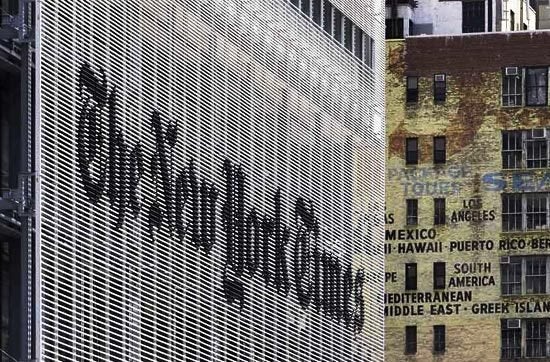
Michael Hirschorn's recent piece in The Atlantic, "End Times," notes that "virtually all the predictions about the death of old media have assumed a comfortingly long time frame for the end of print," and offers up a sensational possibility: "But what if the old media dies much more quickly? What if a hurricane comes along and obliterates the dunes entirely? Specifically, what if The New York Times goes out of business -- like, this May?" Indeed, that would be an epochal cultural event and, not to understate things, a significant loss to the news business in general. I personally can't recall the last time the Times had good news to report in their periodic updates on ad revenues and circulation rates -- there have probably been a few moral victories in the mix, but the big, loud, pounding blur in the world of print sounds like a prelude to a death knell. And, you know, everyone, everywhere, is getting laid off. Good people, too. Nat Hentoff, for Christ's sake!
So, yeah, the piece is compelling, in that "It Could Happen Here!" sort of way. But is Hirschorn right? Or have rumors of the death of the Times been exaggerated? In separate response pieces, Felix Salmon and Rick Edmonds object. (And, just to acknowledge the elephant in the room: for the record, neither accept the premise that this here Huffington Post is the "future prototype" of journalism.)
For Salmon, the idea that the Times will be among the next print organs to fall (which is, I think, a fair assessment of the premise, given the May 2009 drop dead date) is dubious. Smaller print institutions, Salmon notes, are far more vulnerable, and, "as smaller papers close," the Times is likely to "become a replacement for people who've lost their local paper and who shudder at the prospect of ever reading USA Today." That makes sense. I shudder when I'm staying at a hotel and receive the USA Today for free.
More to the point, Salmon objects to Hirschorn's take on the Times' overall value, which he sizes up thusly: "As of December, its stock had fallen so far that the entire company could theoretically be had for about $1 billion." Salmon responds:
Er, no. The NYT has two classes of stock, as Hirschorn knows full well: the secondary-market price of the non-voting stock can't simply be extrapolated to get the amount that someone would need to pay for voting control. And in any case, $1 billion is still a lot of money. To put that number in perspective, over the past four quarters, the New York Times Company has lost about $30 million. I think it's pretty safe to say that the NYT is going to continue to exist in its present form for quite a long time yet.
For Edmonds, his objections are also couched in the idea of innumeracy:
The hypothesis of a May closing is pegged to the expiration then of a $400 million revolving line of credit. Hirschorn is aware that if the Times needs cash, it can borrow against the value of its new office building -- as it has done now to the tune of up to $225 million. The company also announced on Christmas Eve that it has put its stake in the Boston Red Sox up for sale, which could fetch another $200 million.
New York Times Co. Chief Financial Officer James Follo reported at the UBS Global Media conference in December that the company has two $400 million "revolvers," the second expiring in 2011. And it has only drawn down a total of about $400 million between the two. So the company could pay off the first entirely and get by on the second, though in practice it will refinance some of the debt to maintain reserves and flexibility.
Long story short, the company will be able to meet the May deadline. And corporate finance is not like an auto loan, in which the repo man comes if you miss a few payments. As discussed in an earlier Biz Blog post, creditors typically renegotiate the terms -- as they have done to much sicklier newspaper companies than the New York Times Co.
These ideas can be kicked back and forth, of course, and it will be interesting if Hirschorn is able to mount some sort of response.
Personally speaking, however, I'm a little stunned that no one in this conversation is willing to pick over my big problem with Hirschorn's piece, which is that his "death of print" thought exercise is a feeling man's exercise, instead of a thinking man's exercise. Let's consider how the priorities line up in this paragraph from Hirschorn:
The collapse of daily print journalism will mean many things. For those of us old enough to still care about going out on a Sunday morning for our doorstop edition of The Times, it will mean the end of a certain kind of civilized ritual that has defined most of our adult lives. It will also mean the end of a certain kind of quasi-bohemian urban existence for the thousands of smart middle-class writers, journalists, and public intellectuals who have, until now, lived semi-charmed kinds of lives of the mind. And it will seriously damage the press's ability to serve as a bulwark of democracy. Internet purists may maintain that the Web will throw up a new pro-am class of citizen journalists to fill the void, but for now, at least, there's no online substitute for institutions that can marshal years of well-developed sourcing and reporting experience--not to mention the resources to, say, send journalists leapfrogging between Mumbai and Islamabad to decode the complexities of the India-Pakistan conflict.
See, I could give a crap about quasi-urban bohemian rituals because new ones always spring up to replace the old and frivolousness never goes out of style. These contemplations of the end of the New York Times create an opportunity to muse poetically on future-shock sentimentality, but if you want to talk about a "time frame for the end of print," let's have a pragmatic discussion. The Times will probably survive until May. But there are other papers -- significant papers! big urban dailies! -- that may meet their end in that time.
I sit down with the Star-Ledger for about four days each year while visiting family in New Jersey for Thanksgiving. Relative to Bloomfield Avenue, it's my quasi-urban bohemian ritual! And I have a good feeling that this past year will be the last time I indulge in this annual tradition. The Star Ledger serves the city of Newark, and, from what I understand, that's a community that can really stand to have some journalists, keeping people honest. What happens when that paper fails? Maybe its staff heads to micro-locals, beefing up their quality. Maybe they stand around on street corners, like town criers. It seems to me, though, that it creates an environment where corruption could easily flourish.
Also absent from these discussion are the working poor. If you want to know why the internet is not yet the future prototype of journalism, it's because not everyone has the disposable income to purchase laptops and Kindles, and a significant number of people also lack the free time to chill out at the local Starbucks, reflecting on the day's news. We broadband addicts tend to kid ourselves, but in this day and age, it is still far easier to carve out the time and space for a newspaper than it is for the web. Maybe microscopic print gazettes can fill the needs of this audience. Maybe network and cable news can provide critical information (it seems to me that the same barriers of economy and time exist there as well). But I rather think that the short-term "end of print" apocalypse will not be felt by people lamenting their lost community rituals, but by a forgotten class of people losing their hold on their communities.
I've read a lot of musings on the "death of print." Maybe I'm reading all the wrong musings! But from my experience, the plight of these forgotten consumers never enters the discussion. Sadly, I think that I'm a bloody pioneer in this arena. I hope someone will come along to prove me wrong. Maybe by, say, May of this year.
